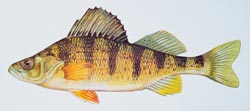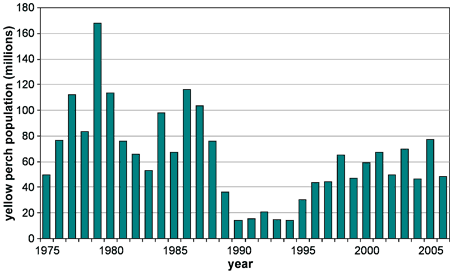Detroit River-Western Lake Erie Basin Indicator Project
Yellow Perch Population
Background
Yellow perch (Perca flavescens) is one of the most popular sport and commercial fish in Lake Erie. Residents along the Detroit River and western Lake Erie remember the once popular "all you can eat fish fries" on Friday nights overflowing with more perch than could be consumed. The big perch dinners disappeared for awhile, but are once again appearing in cities along the water due to an increasing population in recent years.
Yellow perch (Figure 1) feed on small fish, mayfly larvae, caddisfly larvae, amphipods, chironomids, and zooplankton. Mayflies are a very important food resource for the yellow perch fishery. From the late 1980s through the 1990s, after a 40-year absence due to pollution and eutrophication, large benthic invertebrates including mayfly larvae, caddisfly larvae, and amphipods recolonized the basin (Bridgeman et al. 2006). When burrowing mayflies (Hexagenia spp.) recolonized western Lake Erie in the mid-1990s as water quality improved, the yellow perch population once again increased. Yellow perch are very valuable economically and the species is an indicator of the ecological condition of Lake Erie (Bridgeman et al. 2006). Yellow perch are also beneficial because they feed on the nonnative, invasive round goby (Kubb 2000).

Figure 1. Yellow perch (Perca flavescens) (Duane Raver, U.S. Fish and Wildlife Service).
Status and Trends
In the early 1800s, a commercial fishery in the Detroit River produced tons of lake whitefish, yellow perch, and other species (Haas and Bryant 1978). Catches for yellow perch peaked in the late 1800s and decreased substantially thereafter. However, yellow perch remained a large part of the fishery through the 1960s. Commercial fishing continued on the Ontario side of the Detroit River until 1970, when high levels of mercury found in Lake St. Clair closed all of the surrounding fisheries. The Detroit River commercial fishery was never again reopened (Manny et al. 1988).
The Great Lakes Fishery Commission's Lake Erie Yellow Perch Task Group has collected yellow perch population and size data in Lake Erie since 1975. These data show that the Lake Erie yellow perch population increased through the late 1970s, possibly due to lake-wide pollution abatement programs and decreased fishing pressure (Figure 2). Throughout the 1980s, the population was variable until it plummeted in the late 1980s, with very low numbers through the early 1990s. Population declines were possibly due to the lake-wide invasion of zebra and quagga mussels, overfishing and unfavorable weather (Kenyon and Murray 2001). The yellow perch population increased from the mid- to late 1990s and has remained steady through 2006. This higher reproduction rate is likely a result of a greater density of burrowing mayflies and an increase in the spawning success and survival of juvenile fish in the western basin. There also may be an inverse relationship between the peak walleye abundance periods (late 1980s-early 1990s, and more recently since 2003) with yellow perch abundance. When walleye abundance is very high, it appears that yellow perch abundance declines and probably is due to predation (Thomas 2006).

Figure 2. Estimated population in millions of yellow perch (ages 2+) in management unit 1 which encompasses western Lake Erie basin, 1975-2006 (data collected by the Great Lakes Fishery Commission, Lake Erie Yellow Perch Task Group).
Large-bodied benthic macroinvertebrates were eliminated from the western basin from 1960 through 1980, mainly due to phosphorus-induced eutrophication. Therefore, yellow perch had to rely primarily on smaller chironomids and zooplankton as forage. Growth rates and abundance of yellow perch declined through this period in the western basin, in part because of food limitation (Hayward and Margraf 1987). As a result, size of the yellow perch in the western basin has fluctuated along with the population size depending on food supply. After the early 1990s, the yellow perch growth rates have increased along with abundance (Tyson and Knight 2001). Increases in benthic macroinvertebrate abundance are responsible, in part, for the increases in yellow perch growth and reproduction. This dependence on benthic organisms makes yellow perch a useful indicator of the health of the benthic community (Tyson and Knight 2001).
Management Next Steps
The plan for the management of Lake Erie yellow perch is a cooperative and collaborative effort of the Great Lakes Fishery Commission and the Lake Erie Committee member jurisdictions. It is an example of the jurisdictions' commitment to the ongoing sustainability and economic viability of this important fishery. Such collaboration is critical to the proper management of the yellow perch fishery of Lake Erie. One objective is to maintain a sustainable harvest for all areas of the lake, and maintain and promote genetic diversity by identifying, rehabilitating, conserving, and protecting locally adapted stocks.
Researchers and managers should collaborate to estimate Lake Erie carrying capacity for yellow perch in order to help achieve a sustainable population. Further, researchers and managers should continuously assess, set management priorities, and take management action in a process of continuous improvement. Both sport and commercial harvest quotas should be established by managers at conservative levels to help achieve desired goals.
Research/Monitoring Needs
To help ensure maintenance of yellow perch stock diversity and sustainability of the population, a number of areas of needed research and investigation must be addressed. These include:
- mortality – determine if current assessment programs provide accurate estimates of mortality, both at the population and stock-specific levels;
- stock contribution – continue to develop tools to identify stock specific origin (the specific subpopulation that shares some definable attributes of interest to the fishery) of individual fish to determine relative contribution of stocks to the Lake Erie yellow perch population;
- size selective management – determine the utility and management implications of establishing size limits for angling fisheries and mesh size restrictions for commercial fisheries for achieving fishery objectives;
- seasonal closures of fisheries/sanctuaries – evaluate the value of these techniques in improving fry survival and/or protecting fish before they spawn;
- fish community interactions – identify interactions between populations that might impact production; and social and economic effects of population abundance – estimate social and economic impacts of various fishery and harvest objectives in order to maximize benefits.
References
- Bridgeman, T.B., D.W. Schloesser, and A.E. Krause. 2006. Recruitment of Hexagenia mayfly nymphs in western Lake Erie linked to environmental variability. Ecological Applications 16(2):601-611.
- Haas, R.C., and W.C. Bryant. 1978. Status of the fisheries resources in Lake St. Clair and connecting waters. Michigan Department of Natural Resources, Lake St. Clair Great Lakes Station, Mt. Clemens, Michigan.
- Hayward, R.S., and F.J. Margraf. 1987. Eutrophication effects of prey size and food available to yellow perch in Lake Erie. Transactions of the American Fisheries Society 116(2):210-223.
- Kenyon, R., and C. Murray. 2001. A review of the Lake Erie and Presque Isle Bay yellow perch sport angling fisheries, 1997-2001. Pennsylvania Fish and Boat Commission, Lake Erie Research Unit, Fairview, PA.
- Kubb, R. 2000. The 2000 Lake Erie perch report.
- Manny, B.A., T.A. Edsall, and E. Jaworski. 1988. The Detroit River, Michigan: An ecological profile. U.S. Fish and Wildlife Service Biological Report 85 (7.17).
- Thomas, M. 2006. The relationship between yellow perch and walleye abundances in Lake Erie. Personal Communications (August 2006).
- Tyson, J.T., and R.L. Knight. 2001. Response of yellow perch to changes in the benthic invertebrate community of Western Lake Erie. Transactions of the American Fisheries Society 130(5):766-782.
Contact Information regarding Yellow Perch Population
Michael Thomas
Michigan DNR, Fisheries DivisionE-mail Address: thomasmv@michigan.gov
Michael Bur
USGS, Great Lakes Science CenterE-mail Address: mbur@usgs.gov